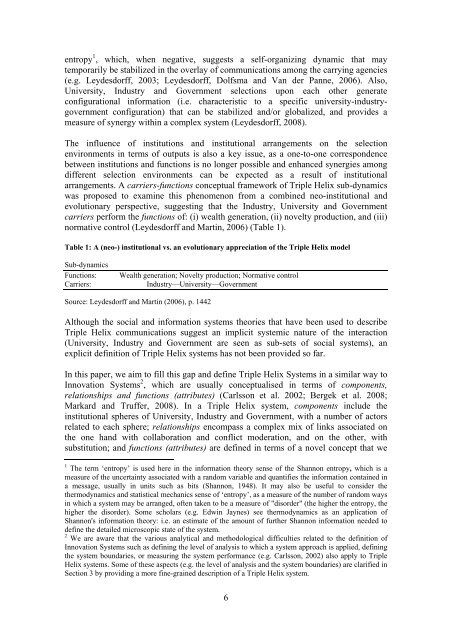A Triple Helix System for Knowledge-based Regional Development ...
A Triple Helix System for Knowledge-based Regional Development ...
A Triple Helix System for Knowledge-based Regional Development ...
- No tags were found...
Create successful ePaper yourself
Turn your PDF publications into a flip-book with our unique Google optimized e-Paper software.
entropy 1 , which, when negative, suggests a self-organizing dynamic that maytemporarily be stabilized in the overlay of communications among the carrying agencies(e.g. Leydesdorff, 2003; Leydesdorff, Dolfsma and Van der Panne, 2006). Also,University, Industry and Government selections upon each other generateconfigurational in<strong>for</strong>mation (i.e. characteristic to a specific university-industrygovernmentconfiguration) that can be stabilized and/or globalized, and provides ameasure of synergy within a complex system (Leydesdorff, 2008).The influence of institutions and institutional arrangements on the selectionenvironments in terms of outputs is also a key issue, as a one-to-one correspondencebetween institutions and functions is no longer possible and enhanced synergies amongdifferent selection environments can be expected as a result of institutionalarrangements. A carriers-functions conceptual framework of <strong>Triple</strong> <strong>Helix</strong> sub-dynamicswas proposed to examine this phenomenon from a combined neo-institutional andevolutionary perspective, suggesting that the Industry, University and Governmentcarriers per<strong>for</strong>m the functions of: (i) wealth generation, (ii) novelty production, and (iii)normative control (Leydesdorff and Martin, 2006) (Table 1).Table 1: A (neo-) institutional vs. an evolutionary appreciation of the <strong>Triple</strong> <strong>Helix</strong> modelSub-dynamicsFunctions:Carriers:Wealth generation; Novelty production; Normative controlIndustry—University—GovernmentSource: Leydesdorff and Martin (2006), p. 1442Although the social and in<strong>for</strong>mation systems theories that have been used to describe<strong>Triple</strong> <strong>Helix</strong> communications suggest an implicit systemic nature of the interaction(University, Industry and Government are seen as sub-sets of social systems), anexplicit definition of <strong>Triple</strong> <strong>Helix</strong> systems has not been provided so far.In this paper, we aim to fill this gap and define <strong>Triple</strong> <strong>Helix</strong> <strong>System</strong>s in a similar way toInnovation <strong>System</strong>s 2 , which are usually conceptualised in terms of components,relationships and functions (attributes) (Carlsson et al. 2002; Bergek et al. 2008;Markard and Truffer, 2008). In a <strong>Triple</strong> <strong>Helix</strong> system, components include theinstitutional spheres of University, Industry and Government, with a number of actorsrelated to each sphere; relationships encompass a complex mix of links associated onthe one hand with collaboration and conflict moderation, and on the other, withsubstitution; and functions (attributes) are defined in terms of a novel concept that we1 The term ‘entropy’ is used here in the in<strong>for</strong>mation theory sense of the Shannon entropy, which is ameasure of the uncertainty associated with a random variable and quantifies the in<strong>for</strong>mation contained ina message, usually in units such as bits (Shannon, 1948). It may also be useful to consider thethermodynamics and statistical mechanics sense of ‘entropy’, as a measure of the number of random waysin which a system may be arranged, often taken to be a measure of "disorder" (the higher the entropy, thehigher the disorder). Some scholars (e.g. Edwin Jaynes) see thermodynamics as an application ofShannon's in<strong>for</strong>mation theory: i.e. an estimate of the amount of further Shannon in<strong>for</strong>mation needed todefine the detailed microscopic state of the system.2 We are aware that the various analytical and methodological difficulties related to the definition ofInnovation <strong>System</strong>s such as defining the level of analysis to which a system approach is applied, definingthe system boundaries, or measuring the system per<strong>for</strong>mance (e.g. Carlsson, 2002) also apply to <strong>Triple</strong><strong>Helix</strong> systems. Some of these aspects (e.g. the level of analysis and the system boundaries) are clarified inSection 3 by providing a more fine-grained description of a <strong>Triple</strong> <strong>Helix</strong> system.6










